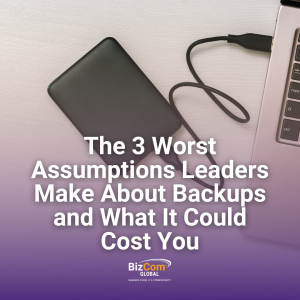
Backups don’t always mean recoverable data. Learn the real difference between backups and resilience.
For most business leaders, “We have backups” feels like a comforting statement — like insurance for your data.
But here’s the truth: having backups is not the same as being resilient.
In fact, many companies don’t realize their backup systems are flawed until something goes wrong — and by then, the damage is already done. The problem isn’t a lack of data. It’s the false sense of security that comes from making the wrong assumptions.
Let’s break down the top three.
Assumption #1: “If We’re Backing Up, We’re Covered”
Why it’s risky:
Backups may be happening — but are they complete, tested, and recoverable?
Too often, businesses discover after a breach or crash that their backups only included some data, or worse, were corrupted or out of sync.
What to do instead:
- Don’t assume. Verify. Ask your IT provider for a clear, written outline of what’s backed up, how often, and how it’s tested.
- Run periodic test recoveries — not just backups. Can you restore all data quickly and completely?
Business impact:
A non-functional backup can delay recovery by days — costing tens of thousands in lost productivity, customer trust, and regulatory exposure.
Assumption #2: “Backups = Business Continuity”
Why it’s risky:
Backups are just files. They don’t get your systems running, your team online, or your workflows back in motion.
You might have a copy of your data… but if you don’t have a tested business continuity plan, you may not be able to use it quickly enough to avoid serious disruption.
What to do instead:
- Develop a simple, actionable business continuity plan that includes roles, timelines, communication protocols, and recovery procedures.
- Don’t forget about access — where will your team work from? What systems do they need?
Business impact:
Every hour your team is offline is an hour of lost revenue and productivity. Resilience is about recovery — not just storage.
Assumption #3: “Our Cloud Tools Are Already Backed Up”
Why it’s risky:
This is one of the most dangerous myths today.
Popular platforms like Microsoft 365, Google Workspace, or Salesforce do not provide full backup and retention by default. If a file is deleted, corrupted, or overwritten, you may only have a short window to recover — or no option at all.
What to do instead:
- Confirm your backup coverage for every cloud platform.
- Consider third-party backup solutions that extend retention and ensure recovery options.
- Don’t assume “the cloud” means “taken care of.”
Business impact:
Accidental deletions, insider threats, and sync errors can wipe critical data — and leave you with no recourse if your backups don’t exist or don’t cover cloud systems.
So… What’s the Difference Between Backups and Resilience?
Backups are copies of your data.
Resilience is your ability to bounce back — with speed, clarity, and minimal disruption.
True resilience includes:
- Regular, tested backups
- A written recovery plan
- Defined roles and communication paths
- Systems to restore access quickly
- Ongoing reviews as your tech stack evolves
Final Thought: Backups Are a Tool. Resilience Is a Strategy.
Don’t let unchecked assumptions create costly gaps in your safety net. Your business has worked too hard to be vulnerable to something preventable.
Need clarity on your current backup and continuity plan?
Book a Business Continuity Review with BizCom Global — and let’s make sure your systems are resilient, not just “covered.”

